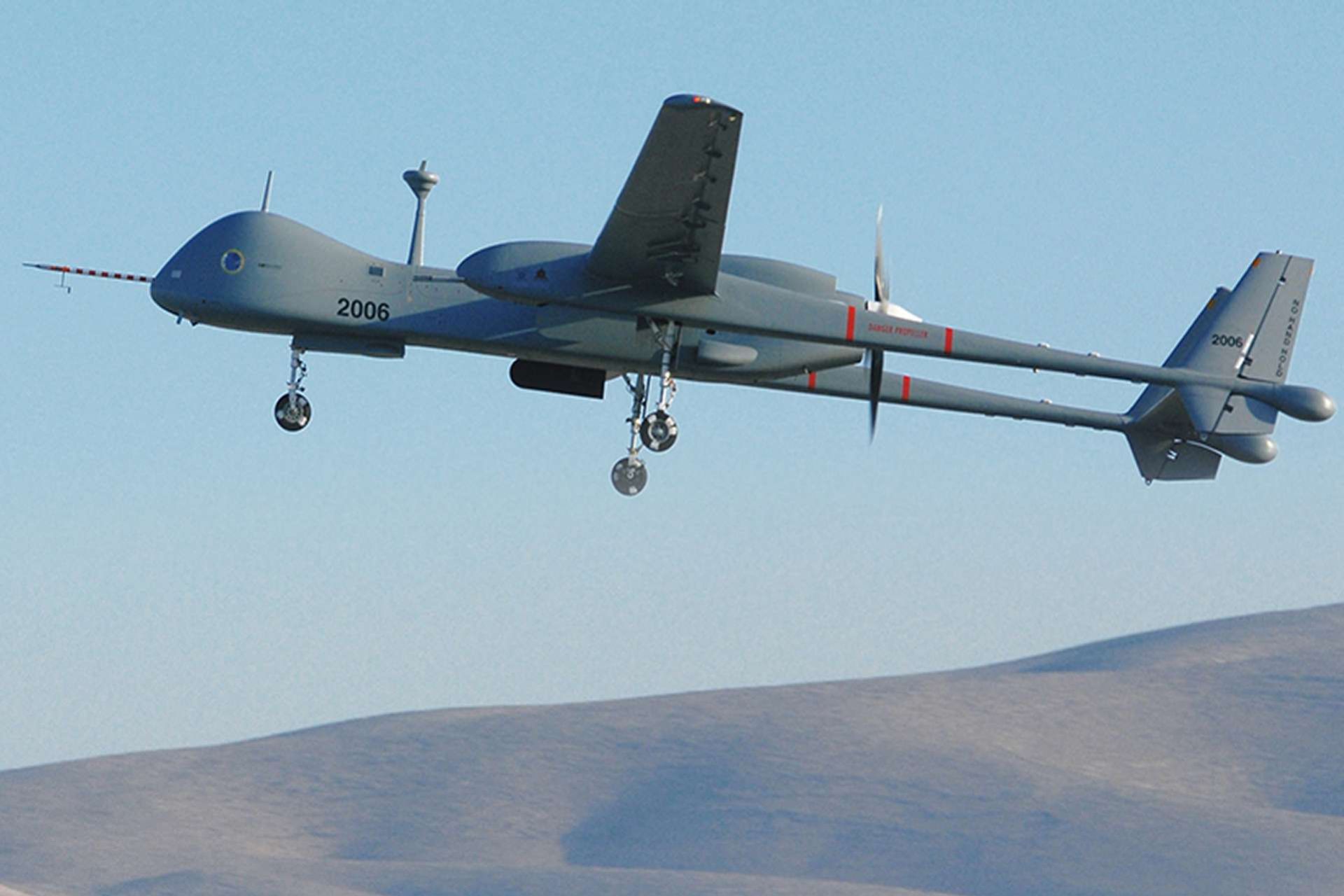Breaking news
Israeli Heron TP Drones Enter Active Duty with German Air Force.
On May 2, 2024, the German Air Force announced that its Heron TP Unmanned Aircraft Systems (UAS) from Israel Aerospace Industries (IAI), leased since 2018, are ready for operations in Germany and globally, with flights set to begin in mid-May.
Follow Army Recognition on Google News at this link

Israel Aerospace Industries Heron TP Unmanned Aircraft Systems (UAS) entered active duty with German Air Force (Picture source: Israel Aerospace Industries)
This announcement follows the granting of a type certificate by the German Military Aviation Authority at the end of 2022, at a time when the Heron TP was being operated from an undisclosed location in Israel.
The primary task of the Heron TP is to support German soldiers and those of allied forces on the ground. For example, these UAVs can accompany convoys to timely detect dangers and thus warn ground troops in real time. Depending on the configuration, the German Heron TP can stay airborne for up to 27 hours. By operating two reconnaissance drones in parallel, an operational area could be continuously monitored for several days.
Furthermore, the Heron TP is intended to bridge the gap between the retirement of the earlier Heron 1 UAS and the introduction of the new European medium-altitude long-endurance UAS known as Eurodrone, with Airbus Defence and Space operating five air vehicles out to 2027.
The Heron TP is configured with electro-optic/infrared (EO/IR) sensors and imaging radar systems to support intelligence, surveillance, and reconnaissance (ISR) tasks. Specifically, the aircraft has been cleared to carry the IAI (Tamam) M-19HD EO sensor turret, which includes zoom and spotter high-definition (HD) day cameras, an HD IR zoom camera, laser designator, laser rangefinder, laser pointer, near-IR laser illuminator, electron-multiplying charge-coupled device camera, and short-wave IR camera. Satellite communications and Bundeswehr data/voice encryption systems are also part of the mission fit.
The Heron TP UAV, a derivative of the Israeli Eitan UAV in use by the Israeli armed forces for over a decade, is the result of a collaborative program led by the UAV Executive Office within the Directorate of Defense Research and Development (DDR&D) of the Israel Ministry of Defense (IMoD), Israel Aerospace Industries (IAI), and Airbus DS Airborne Solutions, a subsidiary of Airbus Group. An agreement to this effect was signed in June 2018, encompassing the leasing of several UAVs, along with maintenance and training services. Consequently, German Air Force personnel have engaged in joint training initiatives alongside their Israeli counterparts at an Israeli Air Force base.
The Heron TP, developed by the Malat (UAV) division of Israel Aerospace Industries (IAI), is classified as a Medium Altitude Long Endurance (MALE) Unmanned Aerial System (UAS). Its design specifically caters to strategic missions, excelling at operations conducted at medium altitudes over extended durations. This feature makes it well-suited for various mission profiles across air, land, and naval domains, and it is currently in service with the Israeli Air Force.
One of the defining characteristics of the Heron TP is its adaptability as a multi-role platform, capable of accommodating a range of mission types. This includes intelligence gathering, surveillance, target acquisition, and reconnaissance, with the ability to switch payloads to suit various mission requirements.
The Heron TP offers flexibility in terms of payload integration and can be equipped with a diverse array of payloads, including an HD Electro-Optical Payload, Synthetic Aperture Radar (SAR), Communications Intelligence (COMINT), Electronic Support Measures (ESM), and more. The drone features an Automatic Taxi-Takeoff and Landing (ATOL) system, the inclusion of triple redundant avionics, satellite communication (SATCOM) for extended operational range, and supports data links for both Line-of-Sight (LOS) and Beyond Line-of-Sight (BLOS) missions.
The Heron TP is powered by a 1,200 hp PT6 Turbo Prop engine, offering the capability to remain airborne for over 30 hours. Operating at altitudes exceeding 45,000 ft and covering distances beyond 1,000 km due to its Beyond Line of Sight (BLOS) capabilities, it is ideal for missions spanning large areas and can reach a maximum speed of 407 km/h. The Heron TP is characterized by its maximum take-off weight of 5,670 kg, a maximum payload weight of 2,700 kg, an overall length of 14 m, and a wingspan of 26 m.
On April 6, 2022, the German government overcame a two-year-long debate to acquire and arm Heron-TP drones, in response to the invasion of Ukraine and the massive use of drones in the conflict. The new German coalition decided to budget 152 million euros for the purchase of 140 missiles intended to equip these drones, leased from Israel Aerospace Industries (IAI). Simultaneously, members of the lower house of parliament's defense committee approved the leasing and arming of the Israeli MALE drones, with an order comprising 60 training missiles and 80 missiles for potential combat use. The delivery of these armed drones was already planned for the year 2024.
This decision marks a significant turnaround, as the previous German government had approved the leasing of three Heron-TP drones in 2018, under an agreement valued at 1 billion euros, but was blocked by the refusal to arm these drones by the Social Democratic Party SPD. The German volte-face is clearly linked to the invasion of Ukraine by Russia, and it could also be in line with French interests concerning the MALE RPAS program. In theory, the Eurodrone, launched in February, is supposed to replace the armed French Reapers as well as the future German Heron-TPs, thereby strengthening European defense cooperation.
It is important to remember that before April 2022, as attested by the Military Balance 2022, Germany had only six Heron 1 unmanned aerial vehicles for heavy intelligence, surveillance, and reconnaissance (ISR) missions, leased since 2010 from Israel Aerospace Industries (IAI).


























